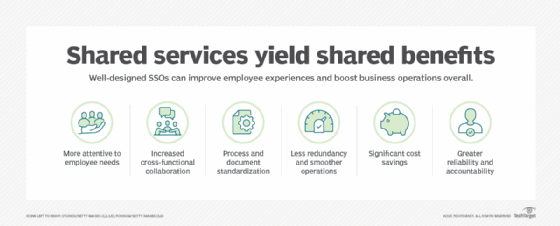
HR shared services models benefit employee experiences
In the new reality of hybrid and remote workforces, shared services organizations smooth work processes, increase collaboration, and improve employee engagement and productivity.
The human resources and IT departments provide support services to employees from the moment candidates visit the company's website to their last day as employees of the company -- and perhaps beyond. Because of these mutual HR and IT touch points, businesses might consider grouping some of their support functions under the umbrella of a shared services organization.
A shared services model can directly improve employee experiences through clearer communication and increased collaboration among employees and departments, more efficient work processes, shared applications, and new business opportunities that can lead to promotions. A company implementing a shared services model can derive additional benefits, including streamlined operations, greater worker productivity and increased cost savings.
Consolidating employee support functions
A shared services model typically consolidates several support functions into one group or merges a single function split across several lines of business into one team. In addition to HR and IT, support functions consolidated under a shared services organization (SSO) can include finance, legal, facilities and others, depending on the industry and company preferences. The SSO typically has one overall leader that reports to the CEO or president.
The general guideline is that each line of business is billed by the SSO for the services received, which is how the SSO generates revenue to cover its expenses. The costs billed back to the line of business may be based on headcount, services provided or another model specific to a company. To ensure an SSO remains competitive, some companies allow the lines of business to evaluate outside vendors to determine if they can offer better price or services than the internal SSO.
A centralized service model differs from the shared services model. It doesn't operate like a service provider nor does it bill back costs to lines of business. To achieve greater efficiency, employees who perform the same administrative function are "centralized" into one team typically at the main office.

Improved employee experiences and related shared services benefits
A shared services model can directly benefit employees in several ways, including better HR services, increased collaboration, shared content, smoother work processes, less redundancy and new innovations.
More attentive to employee needs. SSO members may treat employees in the lines of business as though they're customers and be more responsive to their needs.
Increased cross-functional collaboration. When teams are brought together with a common purpose, there's an opportunity to increase collaboration among team members. By relying on the expertise of team members, they can resolve issues faster.
Process and document standardization. Teams aligned according to a shared services model who may be using similar applications could have more incentive to identify redundancies and inefficiencies, standardize on one application and share the workload across the SSO. For example, a ticketing system often used by IT to track requests from employees and provide them with updates could be adapted to handle HR-related employee issues.
Less redundancy and smoother operations. Moving one or more functions to an SSO can increase operational efficiencies by removing manual processes or sharing systems. When IT and HR are independent, for example, interactions between them tend to be manually oriented. As a team united by a shared services model, the two departments might be more inclined to work together to automate processes or share skillsets for certain tasks.
Significant cost savings. Companies could realize significant savings by merging the same function that operates in multiple lines of business into a single support function. A large enterprise, for example, may have separate HR teams operating in each line of business, each with their own systems and processes. By merging the HR teams, the company could standardize on specific systems and cancel contracts for the others, eliminating duplicate roles and reducing equipment costs.
Greater reliability and accountability. When an SSO bills a line of business for the services it provides, there may be an internal contract between the parties similar to that of an external vendor's agreement. The contract may include the services being offered, pricing and expectations to ensure everyone is accountable for completing their responsibilities.
Potential issues with a shared services model
As with any organizational model, challenges can arise and must be managed to ensure they don't negatively impact employee experiences and the business overall:
- It might be difficult to recruit employees to lead a function within the shared services organization if they don't report directly to the CEO and instead answer to the SSO leader.
- Lines of business might limit and simplify their services since they're paying for them as part of an SSO model. As a result, HR programs may be shortchanged -- for example, a new health and wellness offering might be put on hold due to cost concerns.
- With a focus on reducing costs, lines of business could make shared services purely administrative and, therefore, bypass other SSO support services beneficial to the company and employees.
- If SSO members operate their functions independently rather than collaborate as a team, they could fail to identify redundancies and inefficiencies. HR and IT support functions, for example, might rely on their own existing applications to manage employee requests without looking for ways to synergize tasks.







